To achieve the highest value, you must assess and price AI stock Predicting/Analyzing platforms. Pricing can vary greatly and it's crucial to understand the value you get from your investment. Here are the top 10 suggestions for assessing the price and cost of these platforms:
1. Learn more about the pricing structure
Subscription-based platform: Find out whether you are required to pay an annual or monthly cost. Find out the features included with each level.
Pay-per use: Check whether the amount you pay for is according to the use of the platform (e.g. the number of transactions or data requests).
Freemium model - Check whether there's a no-cost version that has limited features and a paid version for premium features.
2. Compare Pricing Tiers
Compare the features of the various price levels, e.g. Basic, Professional Enterprise, Basic.
Scalability - Be sure that the pricing levels you choose to use are in line with your requirements.
Upgrade flexibility: Find out if you can easily upgrade or downgrade your plan when your requirements evolve.
3. Evaluate Hidden Costs
Data fees. Verify that the platform charges fees for accessing premium data.
Brokerage fees - Check for any additional costs are charged by the platform for trade execution, or for integration with brokers.
API usage: Evaluate whether API access costs are higher or if the API usage is frequent.
4. Test out free demos and trial versions
Trial period: Look for websites that offer a demo or free trial so you can try out the features before you make a decision to commit.
Trial limitations: Determine whether the trial you are using is included in all features or is limited in functionality.
Option of no-commitment: Make sure that you are able to cancel your trial if it doesn't fit your needs.
5. Check for discounts and promotional offers
Annual discounts: Check if your platform offers discounts on subscriptions payable annually as opposed with plans paid on a monthly basis.
Referral programs - Find out whether there are any discount or credits for referring new users.
Ask about bulk or institutional pricing if your organization is a large one.
6. How do you assess return on investment (ROI).
Cost vs. Value: Find out if the functions and projections of the platform are worth the cost. Are you able to save time or make better choices in trading?
Track record of performance - Study the platform's success rate or user testimonials to determine its potential ROI.
Cost alternatives - Compare the platform's price with the cost that could be incurred for not using it (e.g. missed chance, analysis time manually).
Review the Cancellation Policy and Refund Policy
Terms of cancellation: Make sure you are able to make a cancellation without hidden costs or penalties.
Go through the policy on refunds to determine whether you are eligible for the refund you need for unredeemed subscription portion.
Auto-renewal: Check if the platform automatically renews your subscription and how to remove yourself from the subscription.
8. Review Transparency of Pricing
Clear pricing page: Check whether the platform has pricing pages that are complete, transparent and doesn't include any hidden charges.
Customer Support: Call customer service for clarification on any pricing information that is unclear or added charges.
Contract Terms: Understand the long-term obligations and penalties, by reviewing the contract clauses.
9. Compare to Competitors
Feature comparison: Compare the pricing and features offered by the platform to its rivals to make sure you're getting the best price.
Review of user reviews: Read user feedback and check whether other users agree that the platform is worthwhile.
Market positioning: Find out whether it's priced at the high end, mid-range or low-cost alternative and if it is in line with what you would expect.
10. Calculate the Long-Term Costs
Price increases: Check whether the platform has a history of price increases and the frequency at which this happens.
Features that are added: Find out whether your current plan has new features or requires an upgrade.
Costs for Scalability: Ensure the pricing of your platform is reasonable as your trading activities or requirements for data grow.
Bonus Tips
Test different platforms. Compare the performance and value of various platforms by testing their capabilities during free trials.
Negotiate prices: If you have a large number of customers or belong to an organization, ask for custom pricing and discounts.
Search for educational tools that are free and resources. Some platforms offer tools for education or resources for free.
These tips will help you evaluate the pricing and costs of AI software for predicting and analyzing stocks. You can pick one that is suitable for your budget while delivering the features you need. A platform that is priced correctly should strike a compromise between functionality, affordability and performance in order to optimize the value of your trading. See the best get more info about ai trade for website advice including ai trading tools, investing ai, AI stock picker, ai investing app, ai for investing, trading ai, ai for investing, ai investing, investing ai, best AI stock trading bot free and more.

Top 10 Tips On Risk Management Of Ai Trading Platforms That Predict/Analyze Stock Prices
Any AI trading platform that predicts or analyzes stocks has to have risk management in place that is crucial to safeguard your capital and limiting losses. Platforms that have robust risk management features can assist you in navigating turbulent stock markets and make an informed decision. Here are 10 top strategies for evaluating the risk management capabilities of these platforms. capabilities:
1. Review Stop-Loss and Take-Profit Features
Customizable level: You should be able customize the stop-loss/take-profit levels of individual trades and strategies.
Find out if the platform allows the use of trails stops. They automatically adapt themselves when market moves in your favor.
Guaranteed stops: Verify if the platform offers guaranteed stop-loss orders, which guarantee that your position will be closed at the specified price regardless of market volatility.
2. Assess Position Sizing Tools
Fixed amount - Ensure that you are able to define the size of your positions in relation to a set amount.
Percentage portfolio: Find out whether the risk can be managed in a proportional way by setting your positions according to percentage of your portfolio.
Risk-reward: Check if your platform lets you determine risk-rewards for each strategy or trade.
3. Look for Diversification support
Multi-asset trading : Ensure that the platform permits you to trade across a variety of asset classes, like ETFs, stocks, as well as options. This will allow you to diversify your portfolio.
Sector allocation: Verify whether the platform provides tools for monitoring and managing sector exposure.
Geographic diversification - Check that the platform offers trading on international markets. This will allow you to spread geographical risks.
4. Evaluation of leverage and margin controls
Margin requirements. Be sure to know the requirements for margin prior to trading.
Limits on leverage: Find out whether the platform permits users to set leverage limits to manage the risk of exposure.
Margin call: Check whether the platform provides timely notification for margin calls. This will help avoid account closure.
5. Assessment of Risk Analytics and Reporting
Risk metrics - Check that your platform has crucial risk metrics, such as the Sharpe ratio (or Value at Risk (VaR)), or drawdown (or value of portfolio).
Evaluation of scenarios: Make sure the platform you're using lets you simulate market scenarios and assess the risk.
Performance reports: Check whether you can obtain detailed performance reports from the platform, including risk-adjusted results.
6. Check for Real-Time Risk Monitoring
Monitoring of your portfolio. Make sure that your platform can monitor in real-time the risk of your portfolio.
Alerts and notifications: Check the platform's ability to provide real-time warnings of situations that could be risky (e.g. breached margins or stop loss triggers).
Risk dashboards: Ensure that the platform has customizable risk dashboards to give you a complete view of your profile.
7. How to evaluate the results of Stress Testing and Backtesting
Stress testing: Ensure the platform lets you stress test your portfolio or strategies in extreme market conditions.
Backtesting: Check whether the platform allows backtesting strategies based on old data to gauge risk and performance.
Monte Carlo simulations: Verify that the platform is using Monte Carlo simulations to model the possibility of outcomes and determine the risks.
8. Verify Compliance with Risk Management Regulations
Check for regulatory compliance: Verify that the platform's compliance with the applicable Risk Management Regulations (e.g. MiFID II for Europe, Reg T for the U.S.).
Best execution: Make sure that the platform follows the best execution practices, making sure that trades are executed at the most competitive available price to minimize the chance of slippage.
Transparency. Verify that the platform is clear and provides clear disclosures about the risks.
9. Examine the parameters of risk that are user-controlled.
Custom risk rules - Make sure the platform permits you to create your own risk management guidelines.
Automated risk control: Verify that the platform enforces the rules of risk management automatically, based on the pre-defined guidelines.
Manual overrides Check if you can manually override the automated risk control in a situation of emergency.
Review user feedback and case research
User reviews: Conduct user studies to evaluate the platform's effectiveness in managing risk.
Case studies: Search for examples or testimonials that demonstrate the risk management capabilities of the platform.
Community forums: Check whether the platform has members who are willing to share their strategies and strategies to manage the risk.
Bonus Tips
Trial time: You can make use of a demo or a no-cost trial to try out the risk management tools on the platform.
Support for customers: Ensure that the platform provides robust support to any questions or issues that are related to risk management.
Educational resources: Check whether the platform offers education resources or videos on risk management best practices.
With these suggestions, you can effectively assess the potential risk management capabilities of AI stock Predicting/Analyzing trading platforms, ensuring you choose a platform that helps protect your capital and minimize the possibility of losses. Risk management tools that are robust are vital for trading in volatile markets. Read the best best ai for stock trading for website tips including can ai predict stock market, ai copyright signals, AI stock prediction, best stock prediction website, ai tools for trading, ai share trading, trading ai tool, AI stock prediction, best AI stocks, stock predictor and more.
